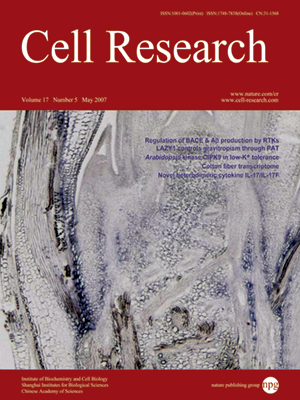
Volume 17, No 5, May 2007
ISSN: 1001-0602
EISSN: 1748-7838 2018
impact factor 17.848*
(Clarivate Analytics, 2019)
Volume 17 Issue 5, May 2007: 449-457
ORIGINAL ARTICLES
Mitotic phosphorylation of PRC1 at Thr470 is required for PRC1 oligomerization and proper central spindle organization
Chuanhai Fu1,2,*, Feng Yan1,*, Fang Wu1, Quan Wu1, Joseph Whittaker3, Haiying Hu4, Renming Hu4 and Xuebiao Yao1,2
1Laboratory of Cellular Dynamics, Hefei National Laboratory and the University of Science and Technology of China, Hefei 230027, China
2Department of Physiology, Morehouse School of Medicine, Atlanta, GA 30310, USA
3Department of Anatomy & Neurobiology, Morehouse School of Medicine, Atlanta, GA 30310, USA
4Department of Endocrinology, Huashan Hospital, Fudan University School of Medicine, Shanghai 200040, China
Correspondence: Xuebiao Yao(yaoxb@ustc.edu.cn )
During cell division, chromosome segregation is orchestrated by the interaction of spindle microtubules with the centromere. A dramatic remodeling of interpolar microtubules into an organized central spindle between the separating chromatids is required for the initiation and execution of cytokinesis. Central spindle organization requires mitotic kinesins, the chromosomal passenger protein complex, and microtubule bundling protein PRC1. PRC1 is phosphorylated by Cdc2 at Thr470 and Thr481 during mitosis. However, the functional relevance of PRC1 phosphorylation at Thr470 has remained elusive. Here we show that expression of the non-phosphorylatable mutant PRC1
T470A but not the phospho-mimicking mutant PRC1
T470E causes aberrant organization of the central spindle. Immunoprecipitation experiment indicates that both PRC1
T470A and PRC1
T470E mutant proteins associate with wild-type PRC1, suggesting that phosphorylation of Thr470 does not alter PRC1 self-association. In addition,
in vitro co-sedimentation experiment showed that PRC1 binds to microtubule independent of the phosphorylation state of Thr470. Gel-filtration experiment suggested that phosphorylation of Thr470 promotes oligomerization of PRC1. Given the fact that prevention of the Thr470 phosphorylation inhibits PRC1 oligomerization
in vitro and causes an aberrant organization of central spindle
in vivo, we propose that this phosphorylation-dependent PRC1 oligomerization ensures that central spindle assembly occurs at the appropriate time in the cell cycle.
Cell Research (2007) 17:449-457 doi: 10.1038/cr.2007.32; published online 17 April 2007
FULL TEXT | PDF
Browse 2055


